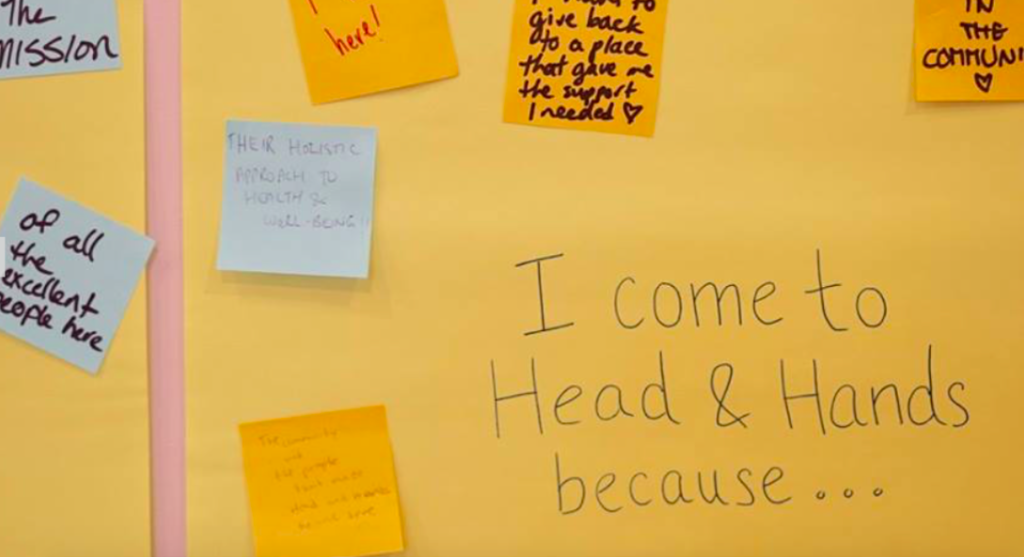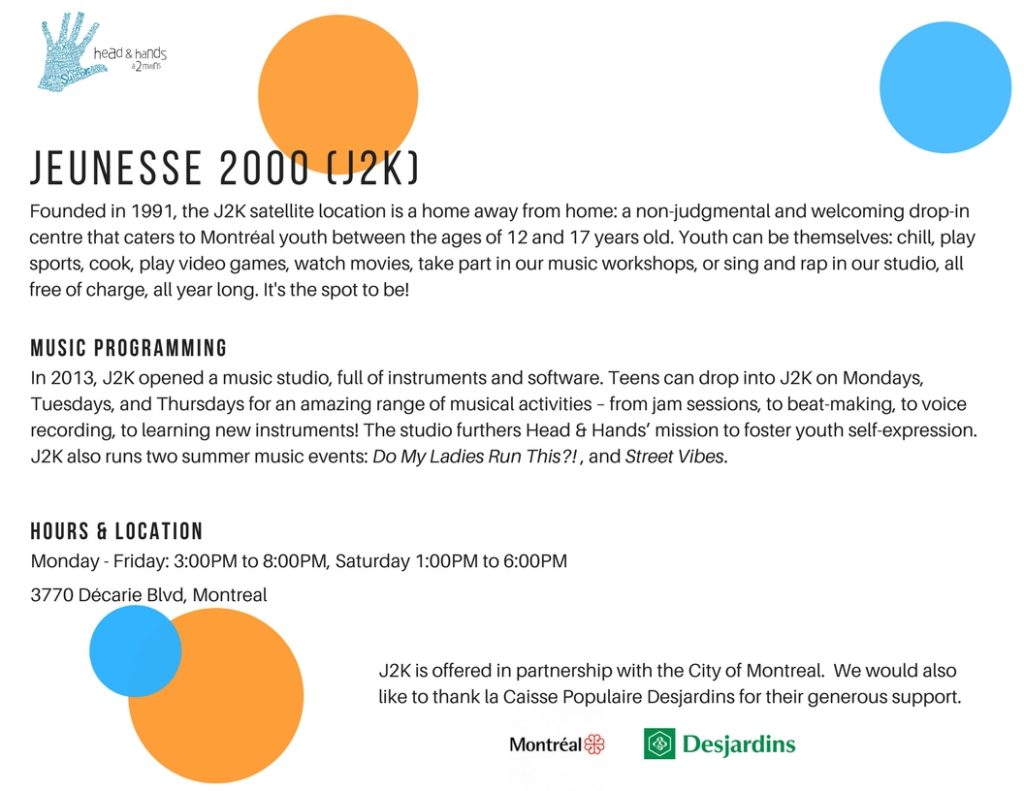Youth and privacy in the Americas: Head and Hands/À deux mains, Canada
How do youth allies promote young people’s critical thinking on privacy, in informal learning contexts in the Americas? This blog post is part of a series showcasing the work of different organizations at the intersection of youth development, digital rights, and online safety.
Quick facts
Who: Andrea Clarke from Head & Hands/À deux mains
What: Medical, legal and social services
Mission/vision: To work with youth to promote their physical and mental well-being
Where: Canada
Since: 1970
Years of operation (as of February 2018): 48
Works in the fields of: Harm reduction, risk prevention
Post summary: Head & Hands is a youth harm reduction organization that works with marginalized youth in Montreal, Canada. They align their organizational practices with their beneficiaries’ right to confidentiality, and explore the implications of personal data for consent in their sexual education efforts.
Highlight quote from the interview: “There’s this tendency to be both dismissive and alarmist when it comes to youth use of technology. Somehow they are victims of technologies, but we also have the feeling that they use technology too much. Either they are savvy and competent, and we should work with them and trust them and grow our knowledge with them, or they’re just not, and they’re at risk. There is this odd dichotomy of not trusting them, thinking they don’t understand what privacy is, but also decrying the ubiquitous nature of tech in their lives.”
More resources: Head & Hands’ website
Head and Hands started when Mark Earley and Pat Crawshaw, street workers then affiliated with the YMCA, started their own independent organization to provide youth services in 1970. Almost five decades later, Head & Hands is a key institution for youth in Montreal, and, in the context of this series on youth and privacy online, a robust organizational example of programming that puts harm reduction and dignity at the center. Their goal is to support youth emotional and physical well being using a harm-reductive and holistic approach, and they offer a broad array of medical, legal and social services. I am grateful to Andrea Clarke, executive director of Head & Hands, who made time to share her wisdom on youth programming; and I am grateful to Lex Gill and Yuan Stevens, who referred me to Head & Hands in the first place.
Working at an organization with decades of work with youth who have been oppressed by different systems, Andrea has a very eloquent way to address the way youth and technology is discussed publicly. “There’s this tendency to be both dismissive and alarmist when it comes to youth use of technology. Somehow they are victims of technologies, but we also have the feeling that they use technology too much. Either they are savvy and competent, and we should work with them and trust them and grow our knowledge with them, or they’re just not, and they’re at risk. There is this odd dichotomy of not trusting them, thinking they don’t understand what privacy is, but also decrying the ubiquitous nature of tech in their lives.”
Head & Hands’ work in harm reduction is not overtly related to online privacy; they focus on providing medical services, street work like needle exchange and unused inhalation gear, and counseling to navigate the judicial system in Canada. Online privacy is a component of their sexual education curriculum.
I decided to feature them, along with other youth organizations for which technology is a core part of the programming, because I consider their execution of the harm reduction framework can make sense of youth and online privacy as a phenomenon where youth have agency and, at the same time, are recipients of environmental influence: the practices of their peers and the adults around them, and the sociotechnical conditions that shape their information-sharing. Youth and privacy advocacy can seek to modify the environment by, for example, pushing for social media platform design that is aligned with youth’s right to privacy.

Harm reduction is an international movement in public health that views individuals as responsible for their own choices and as both agents and recipients of environmental influence. Alan Marlatt cites research that claims the origins of this movement as an approach to drug problems can be traced back to the 19th century, although it arose in contemporary advocacy in response to the growing AIDS crisis in the 1980s (Marlatt, 1998, 30). In Canada, harm reduction was first recommended as the framework for the national drug strategy in 1987 (Riley 1994, cited in Marlatt, 1998).
One of the key characteristics of the harm reduction framework, which makes it productive for the discussion of youth and online safety issues, is that it is a public health alternative to the moral/criminal and disease models of drug use and addiction (Marlatt, 1998, 49). “The focus is not on whether the specific behavior is good or bad, right or wrong; in harm reduction, the emphasis is on whether the behavior is safe or unsafe, helpful or harmful. Harm reduction is about what works (pragmatism) and what helps (compassion) (Marlatt, 1998, xvii).”
One of the critical strategies in harm reduction is to work and talk with, not at, individuals or groups; and engage them “where they are,” on their terms. The framework itself emerged primarily as a “bottom-up” approach based on addict advocacy; needle exchange programs for injection drug users began in the Netherlands in response to input from drug-using participants in a research project (Marlatt, 1998, 52). Other strategies rely on modifying the environment, and on implementing public policy changes.
Head & Hands’ work in youth online privacy takes place through workshops, though not dedicated technology workshops; they fit into their broader sexual education curriculum. Their first effort is to train peer educators; they are all youth under twenty-five and have the assignment to lead conversations with those they serve. Head & Hands staff leave space for youth to decide topics that are relevant to them, and they only “try to provide them with information to open up the conversation about consent and information sharing. To talk about their own experience in answering”, says Andrea Clarke.
Though one of their programs, Jeunesse 2000, involves the use of audio technology, Head & Hands’ framework for talking about the digital footprint comes from their other efforts in sexual education: creating workshops where concepts are described in several ways, and where youth can explore the implications of different decisions. Their educational efforts deal with the implications of youth’s sexual activity and their mobile phones. “We believe youth make decisions that make sense to them and, given information, they will use it to make their own decisions. We speak about the permanent nature of taking and sharing photos, how they can be propagated, what it means for your future. Consent in the context of receiving, sending and sharing pictures.”
Their methodology involves training peer educators, all youth under age 25, who will lead conversations on the topic. Andrea said that they have an interest in further developing their own skills around what it means to be safe online, after research they have done and the workshops they have created. They received a grant to study bullying.
One of the aspects of their work that most stood out to me is Head and Hands’ intentional alignment of institutional confidentiality practices and privacy policy with the defense of youth’s right to privacy. “When we get phone calls from parents, we will not confirm or deny that they are beneficiaries. We give them confidential names in the clinic. Referrals from institutions—we will only give the info with client consent.” She describes their work as similar to that of other organizations who know about the privacy invasions that take place when youth have undue contact with the judicial system.
Head & Hands may not work strictly in the field of youth and privacy, but their experience in providing holistic services that put harm reduction and youth rights at the center across different organizational layers, from programming and outreach messaging to institutional confidentiality, sets an example for the next steps in institutional development for youth organizations who intend to uphold their commitment to youth’s right to privacy.

You can read more about Head & Hands/À deux mains on their website.

